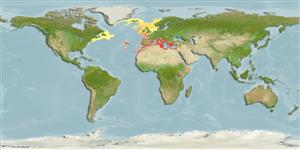Common names from other countries
Environment: milieu / climate zone / depth range / distribution range
Sinh thái học
Tầng nổi; Mức độ sâu 0 - 1022 m (Ref. 122930), usually 100 - 300 m (Ref. 8). Subtropical; 60°N - 27°N, 19°W - 36°E
Eastern Atlantic and the Mediterranean: from Scotland and Norway, south to Canary Islands and east to Turkey, eastern Mediterranean.
Length at first maturity / Bộ gần gũi / Khối lượng (Trọng lượng) / Age
Maturity: Lm ?, range 1 - ? cm Max length : 2.2 cm CL con đực/không giới tính; (Ref. 8)
Minimum depth from Ref. 8. Benthopelagic (Ref. 105772). Mesopelagic (Ref. 122930). Known from pelagic depths between 100 to 200 m (Ref. 92299). Abundant on the upper slope (Ref. 105772). Associated with the gorgonacean coral Isidella elongata (Ref. 122886). Found on seamounts (Ref. 122931). Carries out diel vertical migrations. Diet is based on pelagic crustaceans like euphausiids and calanoids, and bottom feeding has been reported to be minimal, as is the passive ingestion of forams. However, at night, large specimens feed near the bottom on suprabenthic gammarid amphipods. In general, predatory activity occurs higher in the water column at night (Ref. 105773).
Members of the order Decapoda are mostly gonochoric. Mating behavior: Precopulatory courtship ritual is common (through olfactory and tactile cues); usually indirect sperm transfer.
Williams, A.B., L.G. Abele, D.L. Felder, H.H. Hobbs Jr., R.B. Manning, P.A. McLaughlin and I. Pérez Farfante. 1988. (Ref. 2214)
IUCN Red List Status (Ref. 130435)
CITES status (Ref. 108899)
Not Evaluated
Not Evaluated
Human uses
Các nghề cá: Tính thương mại
| FishSource |
Các công cụ
Các nguồn internet
Estimates based on models
Preferred temperature
(Ref.
115969): 13.2 - 15.8, mean 14.3 (based on 141 cells).
Thích nghi nhanh
Chiêù cao, thời gian nhân đôi của chủng quần tối thiểu là dưới 15 tháng (K=0.55-0.62).
Price category
Unknown.
